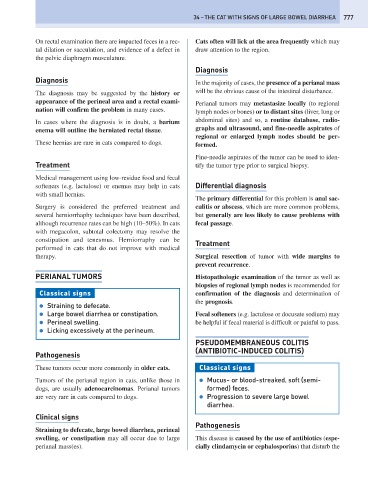Page 785 - Problem-Based Feline Medicine
P. 785
34 – THE CAT WITH SIGNS OF LARGE BOWEL DIARRHEA 777
On rectal examination there are impacted feces in a rec- Cats often will lick at the area frequently which may
tal dilation or sacculation, and evidence of a defect in draw attention to the region.
the pelvic diaphragm musculature.
Diagnosis
Diagnosis In the majority of cases, the presence of a perianal mass
The diagnosis may be suggested by the history or will be the obvious cause of the intestinal disturbance.
appearance of the perineal area and a rectal exami- Perianal tumors may metastasize locally (to regional
nation will confirm the problem in many cases. lymph nodes or bones) or to distant sites (liver, lung or
In cases where the diagnosis is in doubt, a barium abdominal sites) and so, a routine database, radio-
enema will outline the herniated rectal tissue. graphs and ultrasound, and fine-needle aspirates of
regional or enlarged lymph nodes should be per-
These hernias are rare in cats compared to dogs. formed.
Fine-needle aspirates of the tumor can be used to iden-
Treatment tify the tumor type prior to surgical biopsy.
Medical management using low-residue food and fecal
softeners (e.g. lactulose) or enemas may help in cats Differential diagnosis
with small hernias.
The primary differential for this problem is anal sac-
Surgery is considered the preferred treatment and culitis or abscess, which are more common problems,
several herniorrhaphy techniques have been described, but generally are less likely to cause problems with
although recurrence rates can be high (10–50%). In cats fecal passage.
with megacolon, subtotal colectomy may resolve the
constipation and tenesmus. Herniorraphy can be
Treatment
performed in cats that do not improve with medical
therapy. Surgical resection of tumor with wide margins to
prevent recurrence.
PERIANAL TUMORS Histopathologic examination of the tumor as well as
biopsies of regional lymph nodes is recommended for
Classical signs confirmation of the diagnosis and determination of
the prognosis.
● Straining to defecate.
● Large bowel diarrhea or constipation. Fecal softeners (e.g. lactulose or docusate sodium) may
● Perineal swelling. be helpful if fecal material is difficult or painful to pass.
● Licking excessively at the perineum.
PSEUDOMEMBRANEOUS COLITIS
(ANTIBIOTIC-INDUCED COLITIS)
Pathogenesis
These tumors occur more commonly in older cats. Classical signs
Tumors of the perianal region in cats, unlike those in ● Mucus- or blood-streaked, soft (semi-
dogs, are usually adenocarcinomas. Perianal tumors formed) feces.
are very rare in cats compared to dogs. ● Progression to severe large bowel
diarrhea.
Clinical signs
Pathogenesis
Straining to defecate, large bowel diarrhea, perineal
swelling, or constipation may all occur due to large This disease is caused by the use of antibiotics (espe-
perianal mass(es). cially clindamycin or cephalosporins) that disturb the

